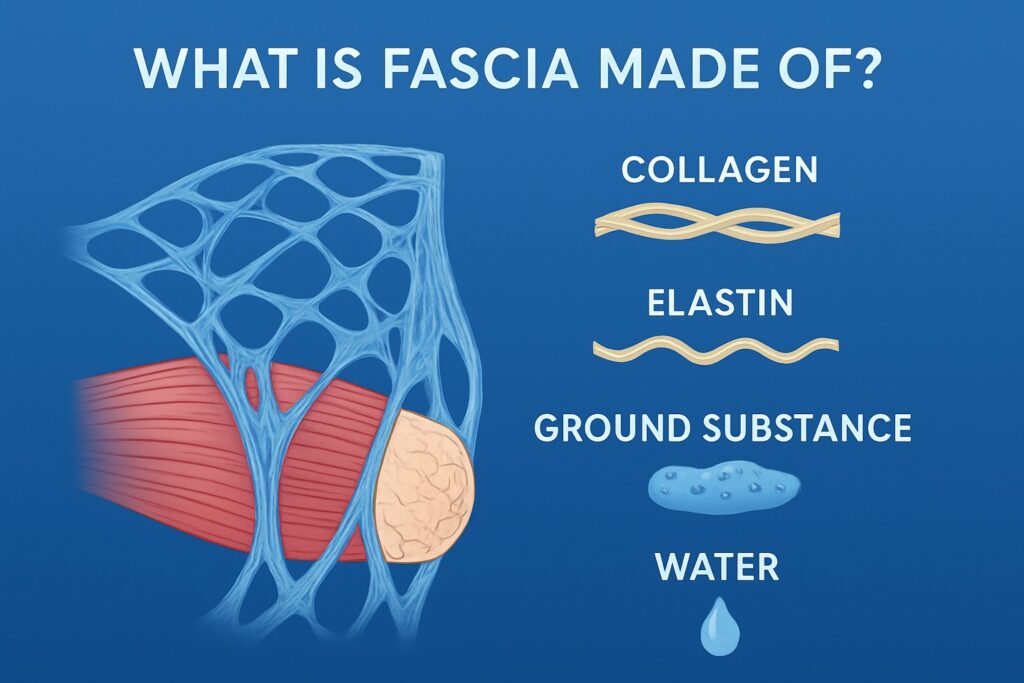Understanding the Body’s Hidden Web of Support
If you’ve ever heard the term “fascia” and wondered what it actually is—or more specifically, what fascia is made of—you’re not alone. Once thought to be just an inert wrapping around muscles, scientists now recognize fascia as one of the most important systems in the body. It provides structural support, enables fluid movement, and plays a critical role in communication between cells, tissues, and organs. But what gives fascia these incredible properties? Let’s explore the building blocks of fascia and how they work together to create a dynamic support system within your body.
What Fascia Is Made Of

Fascia consists mainly of proteins, carbohydrates, and water, forming a specialized connective tissue called the extracellular matrix. This matrix contains collagen, elastin, ground substance (which includes molecules like hyaluronic acid and proteoglycans), and a large amount of interstitial fluid. Fascia also houses fibroblasts, specialized cells that produce and remodel its components in response to movement, injury, or stress. Together, these elements create a strong yet flexible web that holds the body together while allowing movement.
Proteins: Collagen and Elastin
The most abundant protein in fascia is collagen, which provides tensile strength to resist stretch and tearing. Collagen fibers form tightly wound chains of amino acids oriented in multiple directions, helping fascia adapt to a wide range of mechanical forces.
Elastin, another key protein, gives fascia its elasticity. Elastin allows fascia to stretch and return to its original shape, supporting movement, flexibility, and recoil.
The Role of Ground Substance and Water
The ground substance surrounds and supports collagen and elastin fibers. It contains carbohydrate molecules called glycosaminoglycans (GAGs)—most notably hyaluronic acid—which attract and hold water. This gel-like substance acts as a lubricant between tissue layers.
Proteoglycans, proteins with attached sugar chains, organize the matrix, maintain hydration, and influence cell communication. Water forms up to 70% of fascia, enabling it to glide smoothly, absorb shock, and transport nutrients effectively.
Fascia as a Dynamic Web
These components work together to form a three-dimensional web that both separates and connects the body’s internal structures. Fascia surrounds every muscle, organ, blood vessel, and nerve, creating layers that are distinct yet integrated.
This continuity allows efficient force transmission, stabilizes posture, and supports overall movement. As fascia responds to physical stress, hydration, or trauma, the body’s internal structure shifts—either enhancing movement and healing or contributing to dysfunction if left unaddressed.
Fascia in Movement and Yoga
Understanding fascia helps integrate awareness into movement practices. Our 200 Hour Yoga Teacher Training and 300 Hour Yoga Teacher Training both explore fascia’s role in yoga asana and mindful embodiment.
Fascia is more than connective tissue. It is a complex, intelligent system composed of collagen, elastin, water, and carbohydrate-rich molecules, maintained by living cells that respond to your movements. Grasping its composition clarifies its role in flexibility, pain management, injury recovery, and holistic wellness.
You can also explore fascia-focused practices through guided classes on the MVP Wellness App, designed to restore balance and mobility at home. Those interested in therapeutic applications may enjoy our Somatic Healing Certification, which incorporates fascia research for release, regulation, and resilience.
Continuing Your Fascia Education
At My Vinyasa Practice, we provide training and resources that expand your knowledge of fascia’s role in yoga, movement, and healing. From structured learning in Yoga Teacher Trainings to experiential courses like Wisdom of Fascia, you can continue discovering how this hidden web shapes your body and practice.
